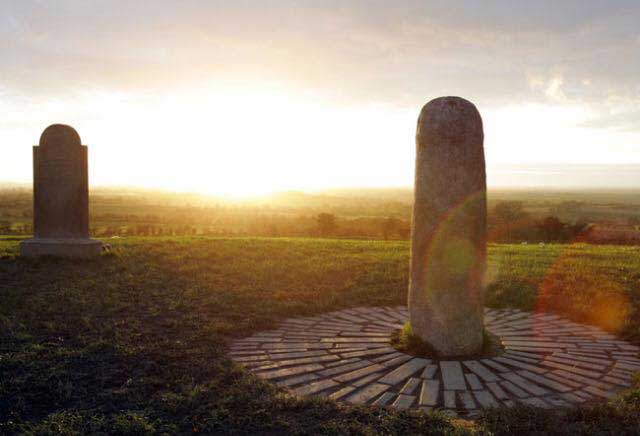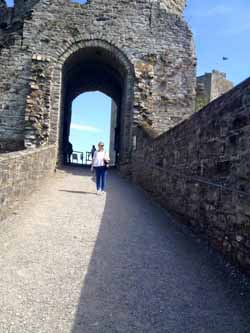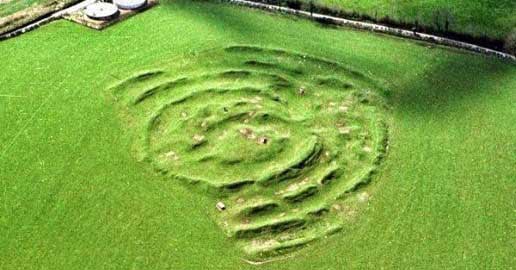County Meath is an ancient sacred landscape that brings our past to life and brings us closer to our ancient roots.
A place where the ghosts of the ancients whisper from the hills, trees and ancient monuments, whose sacred stones have survived the ravages of time.
You will witness an ancient culture that is so deep rooted in Irish culture that parts of its traditions have spread throughout the world.
The art, symbols and engineering feats of the ancient inhabitants of Ireland are dotted all over this vibrant county. The far reaches of our glorious warriors and heroes come closer to reality when you visit this mystical area of Ireland.
One of the Main Kingdoms of Irelands past, Mide is a vast ritual landscape that encompasses everything wonderful about Irelands ancient history. The birthplace of ancient festivals, the seat of the ancient High Kings of Ireland.
The county where the most glorious tombs of our ancestors reside still magnificent and intimidating. Norman Castles, beautiful villages and towns.
A county that is so intertwined with the ancient and modern eras of Ireland that it is a must see for anyone visiting our wonderful country.
1. Bru Na Boinne, Newgrage, Knowth and Dowth

Newgrange, Knowth and Dowth Passage Tombs are the Jewels in the Crown of Ireland’s Ancient East. Situated in the Boyne Valley in the heart of Ireland’s ancient ritual landscape, the sacred spaces of our ancestors.
This is a once in a lifetime experience that you will only get to experience in County Meath, all within the Bru na Boinne experience.
The Bru na Boinne visitor centre is where you will start your magical journey into out ancient past and a unique World Heritage Site. Visiting Bru na Boinne, is a spiritual journey into the Archaeology of Ireland.
Newgrange is a Megalithic Passage Tomb from the pre-historic era known as the Neolithic. It dates from approximately C.3200BC making it approximately 5000 years old, predating Stonehenge and the Pyramids at Giza.
The Tomb is a large mound with one entrance that leads to a long passage and internal chamber with 3 adjacent chambers known as a cruciform, which contains basin stones, which contained cremation burials.
You will also visit Neolithic Tombs Knowth and Dowth and together all 3 major tombs on this site contain the largest quantity of Neolithic megalithic Art in Western Europe.
If you have a bucket list for things to see in Ireland put Newgrange, Knowth and Dowth at the top of that list! For us this spectacular monument stands as a constant and enduring reminder of Ireland’s Gaelic past, and where our glorious mythology and legendary heroes come to life.
Remember you are walking on the sacred ground of our ancestors and everything that you see before you is only a fraction of what exists here, and there is so much more hidden holding their ancient secrets tightly within our earth.
You will see first hand the ancient symbolism of our ancient ancestors with their most sacred spaces.
2. Hill of Tara

The Legendry Hill of Tara is completely engulfed in the history of Ireland.
This sacred place has played a constant and central role in our history and mythology for millennium. The Hill of Tara is the ancient Seat of the High Kings of Ireland and is the sacred site of the ancients where the inaugurations of our High Kings would have occurred.
This is a sacred ritual landscape that dates from the Neolithic period right through to the Iron Age and is a one of a kind ancient site, that is home to many ancient monuments as well as defensive earth works, passages tombs including the world famous Mound of the Hostages You will also see the Stone of Destiny and ancient Standing Stone named Lia Fail.
Tara is a protected monument and is one of Ireland’s most important historical and archaeological sites and is safely under the care and protection of The Irish Office of Public Works.
This ancient sacred landscape is a must see for anyone visiting Ireland. It is a central aspect to the ancient culture of Ireland and is a gateway to understanding our ancient past.
These vast burial mounds and sacred spaces, you will touch the earth of the ancients, seeing and witnessing our ancient past, to become apart of this ancient site is an exceptional spiritual experience. Tara is one of Irelands most important heritage sites, where our myths and legends come to life.
The name Tara is ancient deriving from the ancient Irish language of the Gaels. Teamhair na Teamhrach referring to the name of The Hill of Tara, was also know as Teamhair na Ri, Tara of the Kings.
All the names seem to stem from ancient origins that refer to Tara as a sanctuary and a sacred space. Legends also associated Tara with being the meeting point of the five ancient roads of Ireland which extended from the ancient Kingdoms of Ireland to meet at this sacred site of Kings and Gods.
Our mythology and ancient culture preserved for future generations in a place that seem to summon the spirits of the ancient Gael and bring them back to life, to share their ancient wisdom.
3. Trim Castle

Situated on the South of the River Boyne, Trim Castle is now a ruin of it’s former self but is still a dominant feature standing defensively in the beautiful Village of Trim and is the largest Anglo-Norman Castle in Ireland.
Hugh De Lacy commissioned the massive Keep in 1172 upon being granted the charter and Lordship of Meath by King Henry II of England. Its design and multi phases of construction were overseen by De Lacy and later his son Walter.
Trim is a strategically placed medieval fortress on high ground, placed on a river and close to the Irish Sea.
Trim Castle was famously mentioned in the Norman Poem “The Song of Dermot and the Earl” Trim was also placed close to what was considered the centre of Irish power and royalty and a site of religious importance.
When Visiting Trim Castle you will absorb the magnificent structure, walking around the dominant and formidable Curtain Walls, it’s impossible not be dumb struck at the size, engineering feats and medieval architectural beauty of Trim Castle.
This Castle is not just a building of stone that was born in blood during the Norman Conquest of Ireland, Trim is still alive, although now a shadowy memory of its original magnificence.
Trim Castle is a must see, you will not just be visiting the past but also a part of our modern history.
Although now a living heritage monument Trim has also made its mark on modern cinema playing centre stage in the movie Braveheart staring Mel Gibson.
Trim Castle is the ultimate Medieval Castle experience.
4. Kells Abbey

Situated on an ancient Hillfort the Abbey of Kells is one of Irelands most famous abbeys and was home to one of Ireland’s most famous and precious books.
Situated about 40 miles North of Dublin, Kells Abbey is said to have been founded by Saint Columba in approximately 554AD, this land is said to have been granted to the foundation of the Callach.
The Abbot of Iona retired to Kells in 814AD.
The Abbey is said to have been the sister Abbey of the Island monastery of Iona In 878 AD. Kells became the main house of the Colomba Order in Ireland.
This is when the sacred relics were rehoused at Kells Abbey. The most famous artifact associated with Kells Abbey is the magnificent Book of Kells.
There is some debate as to whether the entire book was scribed in Iona or in Kells but it is academically agreed that a large portion of the priceless manuscript was scribed within the walls of Kells Abbey.
Despite the constant Viking raids on religious sites throughout Ireland, the Book of Kells survived. The book was stolen and damaged in 1006, which is recorded in the Annals of Ulster.
After it was return it remained at Kells until the Cormwellian Invasion of Ireland when it west moved to Dublin and is now housed at Trinity College Dublin.
On your visit to Kells Abbey you will see a wonderful medieval monastic site, with a Round Tower that was used originally as a bell tower and as a safe haven for the monks and their portable wealth during times of war and unrest.
There are a number of 10thCentury religious buildings as well as numerous High Crosses The Cross know as the Market Cross, would have originally been located at one of the Gateways into the Abbey of Kells, it was moved and local legends say that it was used to hang Irish forces that took part in the United Irishmen’s Rebellion of 1798.
A visit to Kells Abbey promises to be an experience that will bring you back in time to an era of religious monastic glory in Irelands past.
5. The Hill of Ward

The Hill of Ward is a place so soaked in the history and legends of Ireland it is mystically situated in the ritual landscape of County Meath. Located approximately 12 miles from The Hill of Tara near the beautiful town of Athboy.
The Hill of Ward is known as Tlachtya in Irish and was a sacred place for our ancient ancestors during the time of the Tuatha De Danann, the ancient Gods of Pagan Ireland. The hill of ward was known as Tlachtya, named after Tlachtya the daughter of the legendry Druid Mug Ruith.
The legend says, she ran away from her home and gave birth to 3 sons and then died. She is said to have been buried within the Hill of Ward. The legend also states that the Hill of Ward was the site of human sacrifice and the birth place of the festival of Samhain.
The legend also states that the wealthy woman of our ancients would sacrifice the children of their slaves on Tlachtya in the hope of improving their own fertility. Samhain is one of the Ancients most sacred festivals and is know better known as Halloween.
The night when the vail between the living and the dead is at its weakest, and the ancestors and daemons return to the realm of the living.
The Hill of Ward played a central roll in the festival of Samhain and is directly visible from the Hill of Tara, it is said that when the first of Samhain was visible on the Hill of Ward then the first of Tara would be lit.
A site that is so surrounded in mystery that there is a vail of intrigue still deeply associated with this ancient site.
